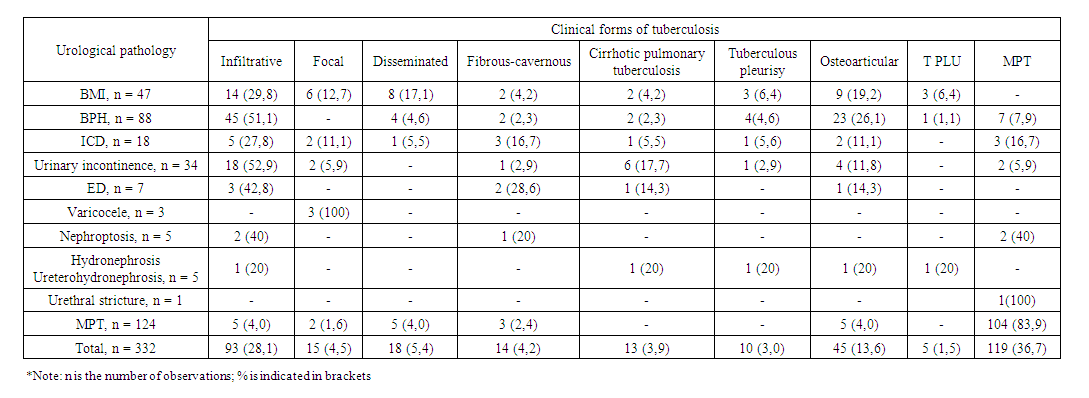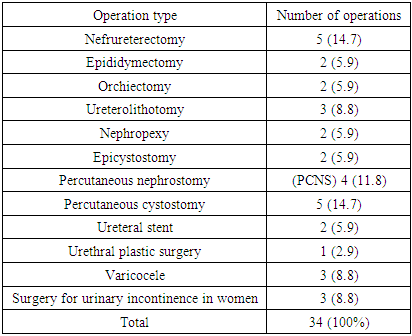-
Paper Information
- Next Paper
- Previous Paper
- Paper Submission
-
Journal Information
- About This Journal
- Editorial Board
- Current Issue
- Archive
- Author Guidelines
- Contact Us
American Journal of Medicine and Medical Sciences
p-ISSN: 2165-901X e-ISSN: 2165-9036
2020; 10(10): 769-772
doi:10.5923/j.ajmms.20201010.09
Received: Sep. 8, 2020; Accepted: Sep. 28, 2020; Published: Oct. 15, 2020

The Role of the Universal Urological Questionnaire in the Screening of Urological Pathology in Patients with Tuberculosis
Z. R. Rashidov1, S. I. Azimov2
1Department of Surgical Diseases, Tashkent Pediatric Medical Institute, Ministry of Health of the Republic of Uzbekistan
2Course of Urology of Faculty and Hospital Surgery of Bukhara State Medical Institute, Ministry of Health of the Republic of Uzbekistan
Copyright © 2020 The Author(s). Published by Scientific & Academic Publishing.
This work is licensed under the Creative Commons Attribution International License (CC BY).
http://creativecommons.org/licenses/by/4.0/

In the world, in recent years, special attention has been paid to the consequences of the negative impact of urological diseases on the health of the population. Determining the true prevalence of urological diseases requires an evaluation of hidden urological morbidity. For solvingthis problem, a targeted survey of the population is more informative, rather than an analysis of data on its use of medical care. This is due to the fact that appealability depends on many factors, such as the development of infrastructure and medical care, its availability, general and medical culture, habits, customs and mentality of the population, which affect its medical activity.
Keywords: Urolithiasis, Osteoarticular tuberculosis, Lymph node tuberculosis, Gen Xpert method
Cite this paper: Z. R. Rashidov, S. I. Azimov, The Role of the Universal Urological Questionnaire in the Screening of Urological Pathology in Patients with Tuberculosis, American Journal of Medicine and Medical Sciences, Vol. 10 No. 10, 2020, pp. 769-772. doi: 10.5923/j.ajmms.20201010.09.
1. Introduction
- The climate of the arid zone of Uzbekistan is characterized by a very hot, dry and long summer and extreme instability of weather in the spring and winter seasons, which undoubtedly affects the adaptive reactions of a healthy and especially sick person. In the summer months, the amount of incoming heat reaches 20-22 thousand calories per 1 sq. m. territory. The temperature of the upper soil layer in summer reaches 50 - 60 degrees Celsius, and the air above it reaches 40 - 45 degrees Celsius.Bukhara region occupies one of the leading places in terms of urological morbidity, in particular, urolithiasis (Urolithiasis) due to the prevailing climatic and environmental conditions. The incidence of ICD in the Bukhara region in 2016-2017 amounted to 147 - 155 cases per 100 thousand population per year, with a republican value of 60 cases per 100 thousand population. Due to the study of the prevalence of urological diseases and its nature, especially in patients with tuberculosis in some regions, such as Bukhara region, it should be taken into consideration Bukhara is located in the arid zone. Improvement of existing, search for new, effective forms and methods of treatment and prevention of urological diseases, including in patients with tuberculosis, is of particular importance due to the need to improve the quality of life and reduce disability.The aim of this study was to study the incidence and structure of urological pathology in patients with tuberculosis in an arid zone.
2. Material and Methods
- To achieve this goal, 936 patients with various forms of tuberculosis were examined. There were 447 men (47.8%), women - 489 (52.2%), the patients' age ranged from 17 to 96 years. Various forms of pulmonary tuberculosis occurred in 504 (53.8%), osteoarticular tuberculosis - in 196 (20.9%), MMT - in 124 (13.4%), intrathoracic lymph node tuberculosis - in 59 (6.3%), tuberculosis pleurisy in 35 (3.7%), tuberculosis of peripheral lymph nodes - in 14 (1.5%), tuberculosis of the skin - in 1 (0.1%), abdominal tuberculosis - in 2 (0.2%) ), eye tuberculosis in -1 (0.1%) patients. We used a universal urological questionnaire developed by the Department of Urology of the Tashkent Medical Academy. The questionnaire included questions regarding the symptoms of the lower urinary tract, urinary tract infection, urinary incontinence, pathology of the male genital area. Pilot testing of the universal questionnaire was previously conducted among patients who applied to the treatment and diagnostic department of the Republican Specialized Scientific and Practical Medical Center of Urology (RSNPMTSU), which showed its high information content. The information obtained was documented using specially developed examination cards, which included the data of an objective examination, the results of ultrasound scanning (USS) and data from urine analyzes. All the data obtained were entered into a specially developed computer program for subsequent statistical processing and accounting. The procedure for conducting the survey was as follows: after completing the survey and filling out the questionnaire, they proceeded to an external examination, paying attention to the condition of the skin, the presence of skin scars, which could indicate previous injuries and operations. For the screening of urolithiasis, presages of the disease were identified, allowing to obtain reliable data on its prevalence. These presages include: - history data, taking into account operations or other interventions undertaken to remove stones or their spontaneous passage; - stones of the kidneys, ureters and bladder, diagnosed by USS; - crystals of salts in the cavities of the kidney, detected by ultrasound, found in the urine sediment by microscopy, which is considered a prognosticationof pre- or microlithiasis. When analyzing the USS data of the urinary system, attention was drawn to morphological changes in the calyx-pelvic system and renal parenchyma (hydronephrosis, hydrocalicosis, cystic formations, tumors, etc.), presages of stones and conglomerates of salts in the renal cavities were noted. When examining urine, special attention was paid to microscopic indices, pH. The latter indicator was singled out especially when assessing the conditions for the formation of crystals, and when determining preventive measures. Microscopy of urine sediment was necessary to detect urinary crystals, determine their mineral identity and quantity. The diagnosis of crystalluria was justified when <3 crystals in 1 μl of urine were found in the counting chamber, which corresponded to 104-105 or more in 1 ml. The following criteria served as the basis for the diagnosis of urinary tract infection (BMI): - the presence of symptoms of BMI, determined by the universal questionnaire; - leukocyturia and bacteriuria, detected by urine microscopy. Clinical, radiological and microbiological data on Mycobacterium tuberculosis (microscopy of urine and pathological material according to Ziehl-Nielsen, inoculation on solid and liquid media, as well as by the Gen Xpert method) served as the basis for the establishment of urinary tuberculosis (UTI).
3. Research Results
- As a result of the examination of 936 patients with various forms of tuberculosis, urological pathology was revealed in 332 patients, which amounted to 35.5% of the examined patients. As the analysis of the structure of the identified urological pathology showed, 88 (26.5%) patients had benign prostatic hyperplasia (BPH), 47 (14.1%) had uncomplicated BMI, 18 (5.5%) had urolithiasis, 34 (10.2%) -various forms of urinary incontinence, in 7 (2.1%) - erectile dysfunction (ED), in 5 (1.5%) - nephroptosis, in 5 (1.5%) - hydronephrosis (ureterohydronephrosis ) and 124 (37.3%) - various forms of genitourinary tuberculosis. The structure of urological pathology is presented in Table 1.
|
 | Table 2. The structure of the revealed urological pathology in patients with tuberculosis |
4. Conclusions
- The clinic of tuberculosis and the effectiveness of its treatment, including pulmonary tuberculosis, is largely determined by the presence of intercurrent diseases that aggravate a specific process and complicate its treatment. The incidence of concomitant pathology in patients with pulmonary tuberculosis ranges from 80% to 100% [1,2,3]. The indications for surgical treatment in the studied patients do not differ from those in the absence of tuberculosis. Absence or insufficient duration of anti-tuberculosis chemotherapy is an absolute contraindication on the part of a specific process [4]. Thus, the use of the universal urological questionnaire made it possible to carry out screening for the detection of urological pathology and showed its high information content among patients with tuberculosis. The data obtained indicate a high proportion of concomitant urological pathology - up to 35.5% in this category of patients, which undoubtedly requires special treatment tactics.
 Abstract
Abstract Reference
Reference Full-Text PDF
Full-Text PDF Full-text HTML
Full-text HTML